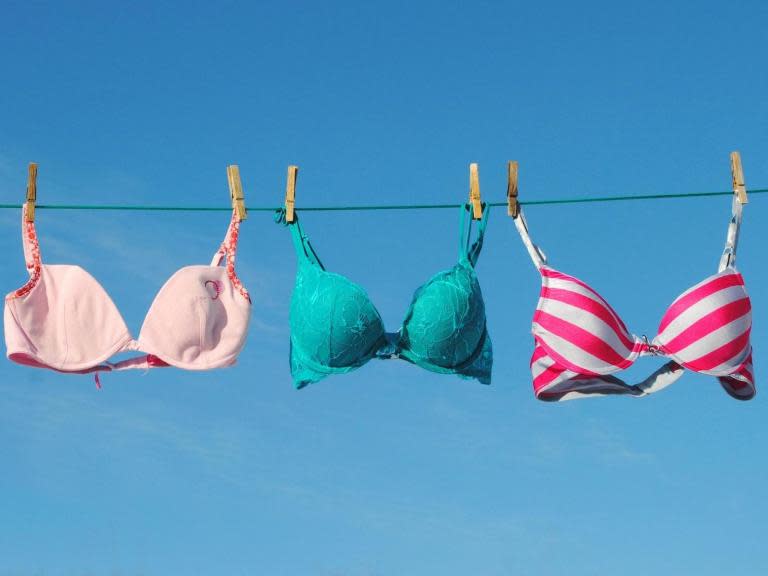What sort of underwear, exactly, should women be wearing to be taken seriously in court?
Ladies! What does your underwear say about you? Are you a red-thonged saucy minx, or do you keep all those ungainly wobbly bits tucked in with some flesh-toned spanks: all tease, no please? Your knicks can speak volumes about how you get your kicks, and that’s why we’ve designed our new “Defendant Drawers”. This high-waisted pair of pants in virginal white cotton are sure to wow the jury and get your rapist convicted.
This week, women across Ireland posted pictures of their underwear online alongside the hashtag #ThisIsNotConsent, after a defence barrister in a rape trial referenced the teenage complainant’s knickers in their closing speech. The 17-year-old’s pants were shown to jurors to consider as evidence that the girl could have been “attracted to the defendant and was open to meeting someone and being with someone”. Defence counsel Elizabeth O’Connell told a court in Ireland: “You have to look at the way she was dressed. She was wearing a thong with a lace front”.
Did they really have to look at the way this girl was dressed though? Women’s underwear has been referred to time and time again in rape trials. The CPS allegedly dropped a rape case in 2014, citing the accuser’s Spanx underwear in the reasoning. Women, it seems, can be wearing absolutely anything and have it used against them when they speak out against sexual assault. Let us not forget the Toronto police officer who, in 2011, told schoolchildren: “Women should avoid dressing like sluts in order not to be victimised”.
One of the most persistent myths about sexual violence is that it is connected to the clothes of a victim. We also know that in approximately 90 per cent of sexual assaults, survivors know the perpetrator prior to the attack, and attacks are most likely to occur in the victim’s or perpetrator’s home, workplace or vehicle. Is a woman’s underwear considered when she is raped in her pyjamas?
These observations are not limited to discussions of consent. This week, ITV’s This Morning held a debate about whether or not it was appropriate for makeup artist Charlotte Tilbury to have worn a keyhole neckline to pick up her MBE from the Queen. Never mind celebrating the business acumen that got her there, let’s focus on her tits.
Alexandria Ocasio-Cortez who recently became the youngest congresswoman in history, was yesterday blasted on Twitter by a conservative journalist for wearing a suit: “I’ll tell you something: that jacket and coat don’t look like a girl who struggles,” he wrote.
Beyond the abhorrence of these respective comments – and their blatant irrelevance to the topics being discussed – the wider debate surrounding women’s clothes has far-reaching consequences. When we broach the perceived appropriateness of women’s clothing choices, we loosen a tap whose persistent drip of “low necklines” or “expensive suits” catalyses a deluge that sees women’s entire credibility mistrusted. Women’s clothing – be it their shoes, their hair, their makeup, their tights, their underwear, their jewellery – has been weaponised against them for centuries, and men scratch their heads and wonder why only 15 per cent of those who experience sexual assault actually report it.
The CPS has, this year, seen the lowest year of rape convictions in 10 years. This particular case, saw an acquittal, but that the accuser’s underwear was thought worthy of mention is what’s of most grave concern.
When men get dressed in the morning they might wonder if their shirt is adequately ironed, or if jeans or trousers would be more fitting for their day ahead. Women must mentally stand within the lines laid out for us and consider if we are erring on the right side of appropriate (nothing too tight, too low cut), frumpy (too loose), feminine (nothing threatening, aggressive, nothing that assimilates the predetermined male wardrobe), trivial (no high heels ladies, less you don’t get taken seriously!) or – it seems – financially secure (spend your money how we tell you). The idea of anyone ever saying: “Ah well, he was wearing a tie, he was obviously asking for it,” is so laughable it would wipe the floor at a stand up routine.
We’ve got to ask ourselves more than just how the “evidence” of this particular girl’s underwear was considered admissible in a rape trial, which was used entirely to discredit the validity of her case or even to strengthen that of the accused. We also have to ask ourselves when we will no longer tolerate discussions of this sort at all.

 Yahoo News
Yahoo News 

